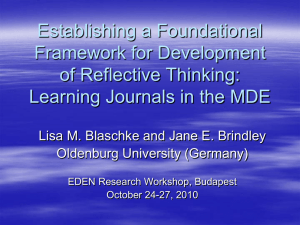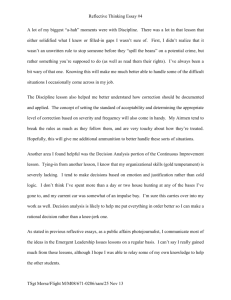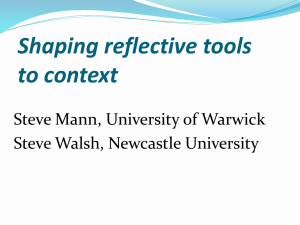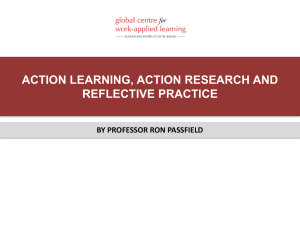Developing reflective practitioners online: the business of blogs in
advertisement
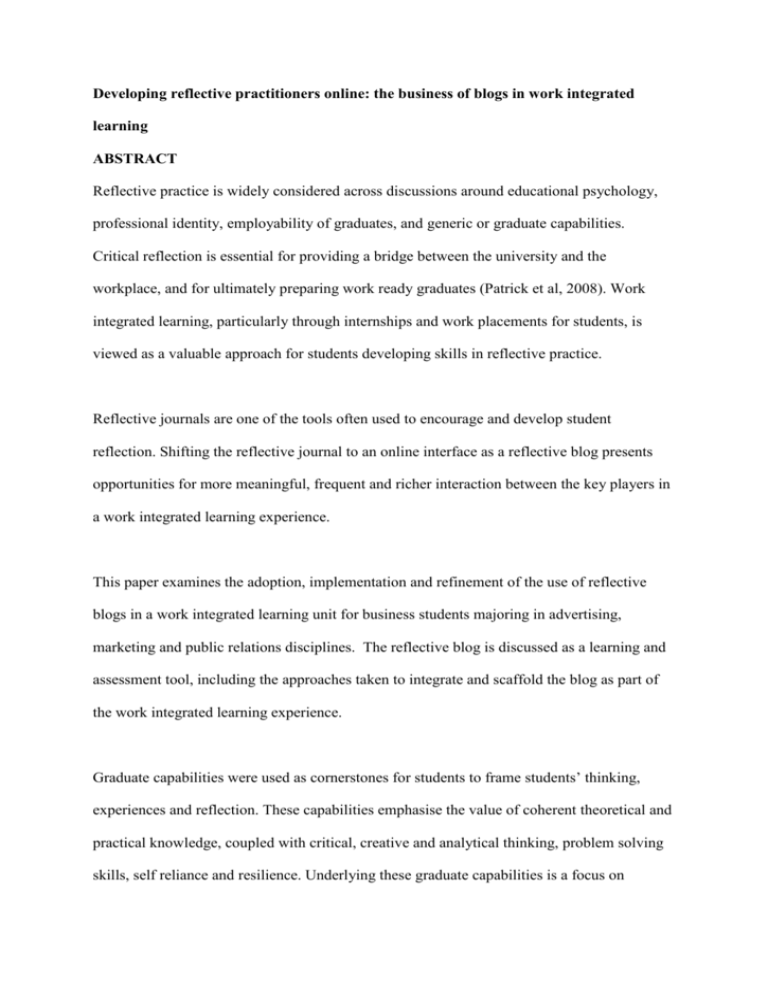
Developing reflective practitioners online: the business of blogs in work integrated learning ABSTRACT Reflective practice is widely considered across discussions around educational psychology, professional identity, employability of graduates, and generic or graduate capabilities. Critical reflection is essential for providing a bridge between the university and the workplace, and for ultimately preparing work ready graduates (Patrick et al, 2008). Work integrated learning, particularly through internships and work placements for students, is viewed as a valuable approach for students developing skills in reflective practice. Reflective journals are one of the tools often used to encourage and develop student reflection. Shifting the reflective journal to an online interface as a reflective blog presents opportunities for more meaningful, frequent and richer interaction between the key players in a work integrated learning experience. This paper examines the adoption, implementation and refinement of the use of reflective blogs in a work integrated learning unit for business students majoring in advertising, marketing and public relations disciplines. The reflective blog is discussed as a learning and assessment tool, including the approaches taken to integrate and scaffold the blog as part of the work integrated learning experience. Graduate capabilities were used as cornerstones for students to frame students’ thinking, experiences and reflection. These capabilities emphasise the value of coherent theoretical and practical knowledge, coupled with critical, creative and analytical thinking, problem solving skills, self reliance and resilience. Underlying these graduate capabilities is a focus on assessment for learning matched with assessment of learning. Using specific triggers and prompts as part of the reflective process, and incorporating ongoing feedback from academic supervisors, students moved from descriptive levels of reflection, to more meaningful and critical reflection. Students’ blogs are analysed to identify key themes, challenges and achievements in the work integrated learning experience. Suggestions for further development and improvement, together with a model of best practice, are proposed. Context AMB310 Internship (the Internship unit) is a 12 credit point unit delivered across a 13 week semester. The Internship unit is housed within the Faculty of Business at Queensland University of Technology (QUT), a major Australian university with more than 40,000 students. The Internship unit is offered as an elective unit to undergraduate students majoring in advertising, marketing and public relations across courses in business and mass communication. The Internship unit is offered throughout the calendar year (ie from February to July in Semester 1, from July to November in Semester 2, and from November to February in Summer Semester). More than 100 students complete the unit each year. The Internship unit aims to provide students with the opportunity to apply and practise knowledge and skills developed through their studies in a business setting with supervision and feedback from industry and academic supervisors. A range of learning activities and assessment tools in the Internship unit are designed to encourage students to reflect on their own skills and capabilities as ‘professionals in training’. The reflective blog, as one item in this range, was introduced into the Internship unit in 2009. Reflective Practice The concept of reflective practice is widely used, both in discussions of teaching and learning and in the development of professionals through higher education and in practice. Reflective practice, including developing skills to be a reflective practitioner, is generally seen as ‘good’ and ‘valuable’. This suggests there is a clear and explicit understanding of what reflective practice is and that it is simple to identify the attributes of a reflective practitioner. However, this is not the case. The pervasiveness and breadth of ideas around reflective practice presents some difficulties in presenting a succinct definition or clear understanding of reflective practice. Some of the seminal work in reflection includes that of Dewey (1933); Schön (1983); Boud, Keogh and Walker (1985); Loughran (1996); Mezirow (1991); and Seibert and Daudelin (1999). Rogers (2001) draws on these and other theoretical approaches to present a very useful analysis of the concept of reflection in higher education, incorporating analysis and discussion of the ideas of reflective practice and what it means to be a reflective practitioner. He identifies common factors across a variety of theoretical approaches to reflection. These factors include terms used to describe reflection, antecedents for reflection, contextual factors, definitional components, the process of reflection and methods used to encourage and enable reflection, and outcomes of reflection. A discussion of reflection from Brechin, Brown and Eby (2000) provides a useful summary and is used as one of the foundations for students’ understanding of reflection in the Internship unit. Reflection is described as enabling individuals to make sense of experiences through examining such experiences in context, through turning thoughtful practice into a potential learning situation, which may help to modify and change approaches to practice. Reflective practice entails the synthesis of self awareness, reflection and critical thinking. It is widely agreed that the important intention of reflective practice is improvement, manifested through a celebration of strengths and demonstrate the development of competence, a record of experiences, and a way to understand practice and make more sense of professional life (see Ghaye, 2007). The ideas of professional identity and generic skills are also transferred to including reflective practice as part of higher education with “many course providers in a variety of fields… [including] a required reflective practice assignment for purposes of instilling a spirit of professional development” (Hobbs, 2007, p. 405). While reflective practice is often set as a task for students with the view to improve their professional practice, it is not without its challenges. Ghaye (2007) questioned whether reflection in higher education is adequately described, explained, justified and practised ethically. Reflection for assessment presents particularly challenges as “forced and evaluated self-exploration raises certain moral and practical issues that cannot be avoided” (Hobbs, 2007, p. 405). Pollard (2008) suggests the dominant idea in reflective practice that experience remains personal and private often leads to reluctance when writing about experience for assessment purposes. Work integrated learning and reflective practice Work integrated learning describes “programs where academic and professional learning are situated together within the work environment as part of a student’s formal course of study” (Franz, 2007, p. 1) and is one term to describe situations where students spend time in a workplace setting. A comprehensive scoping study of work integrated learning commissioned by Australian Collaborative Education Network (ACEN) identifies work integrated learning as “an umbrella term for a range of approaches and strategies that integrate theory with the practice of work within a purposefully designed curriculum” (Patrick et al, 2008, p. iv). Work integrated learning brings “a dual emphasis on the development of both the learner and the organisation... [or] contextual learning founded on the theory of constructivism because learners make meanings by contextualising the content within the learning environment in the workplace” (Delahaye & Choy, 2007, p. 3). Work integrated learning experiences, including internships, are seen across disciplines as a central learning experience incorporating reflection, a key opportunity for students to identify connections between theory and practice, and opportunity for students to develop and demonstrate graduate capabilities or attributes (see Green, Hammer & Star, 2009, pp. 18-20). Reflective journals and blogs Reflective writing is central to the notion of reflective practice. In work integrated learning experiences, it is “common for students to produce reflective diaries, journals, logs or eportfolios in order to reflect upon their experience” (Roberts, 2009, p. 633). Reflective journals are used across a range of disciplines as a useful tool to promote active learning and professional practice that is reflective rather than routine (Thorpe, 2004, p. 327). Blogs, the contracted form of web based logs or weblogs, are essentially online journals. Reflecting a exponential growth in broader settings, in teaching and learning settings particularly higher education, blogs have grown in popularity and influence over recent years (see Farmer, Yue and Brooks, 2008; Bruns and Jacobs, 2006; Williams and Jacobs, 2004). The use of reflective blogs in the Internship unit: a case study Reflective blogs were introduced to the Internship unit in 2009. The introduction was part of a broader review and revision of the Internship unit, in line with a large commissioned Teaching and Learning project around Work Integrated Learning activities across the institution. While structured and for credit work integrated learning experiences, and the concept of reflective practice, are deeply embedded in many discipline areas (eg health and education), these are a fledgling growth area in the business discipline. Prior to the introduction of blogs, the learning activities and assessment tasks designed to develop skills in reflective practice, were centred around an internship plan, reflective journal and final report and presentation on completion of hours required for satisfactory achievement in the Internship unit. Students could choose how they maintained a reflective journal. Around half kept a reflective journal as a ‘soft copy’ file (eg Word document which was updated throughout their internship placement) while the other half selected a ‘hard copy’ file (eg handwritten notebook). There were no specific requirements set around the number of entries required for the journal, though students were encouraged to make entries at least weekly during their internship placement. Students were directed to online and other resources about reflective practice, including tools and techniques for reflective writing. Students were required to submit the reflective journal with the final report for the unit, but the journal was not assessed. As such, the reflective journal was designed to act as a learning activity for students which contributed to an assessment item (the final report and presentation). The reflective journals submitted by students varied – a few demonstrated deep and critical reflection, but most focused on describing events, with little or no analysis, and in turn, no evidence of learning, explanation, or plans for future action. Pavlovich (2007) has synthesised some of the literature of the reflective process, including dimensions of reflection, and suggests four key dimensions or levels of reflection – description, analysis, understanding or new meaning, and action. In the reflective journals, most students’ reflections were at the first level of description, providing often shallow narratives of tasks and activities during their internship placements. On review of research literature in the area of reflective practice, particularly reflective journals, and consideration of existing learning activities and resources available in the unit, it was agreed by the teaching team that a more structured and well scaffolded approach to reflection in the Internship unit would contribute to the quality of students’ reflection and the development of students’ skills as reflective practitioners. One of the major shortcomings of the reflective journal was that it was not submitted until the end of the internship placement, which meant no opportunities were provided for academic or industry supervisors to provide students with feedback on their reflective journal entries. Blogs were seen as a convenient method for academic supervisors to provide regular feedback to students and develop the coaching role in reflective practice more strongly. The blogs were incorporated into the Blackboard online teaching site for the Internship unit. The blogs were set so that they could be viewed only the individual student and the academic supervisors. Consideration was given to other settings or blog software that would open blogs to broader audience (ie all students enrolled in the Internship unit, industry supervisors). However, the notion of reflection as an often deeply personal experience, issues of privacy and confidentiality, and discussions with students enrolled in the Internship unit, led to the decision to allow only restricted, rather than more open access to blogs. The teaching team developed more explicit learning resources around reflection, clearer objectives and more prescriptive requirements around reflective writing on blogs, and a range of tools and triggers which students could choose as ‘hooks’ for reflection. These were developed from a review of the literature and discussions with academic colleagues, particularly through networks involved in work integrated learning activities. The notion that reflective practice should be taught, partnered by recognition of the need for explicit instruction around reflective practice (see Russell, 2005) also underpinned this approach. Key learning resources included frameworks that students could draw on for their reflective writing in blogs. These included: Using triple entries (usually as headings) in a blog focusing on description, reflection or analysis, then plans for future action; Writing to reflect on, in and for action (see particularly Schön, 1987); Structuring blog by summary, new learning, emerging questions, personal reaction as suggested by Francis (1995); Working to five levels of reflective writing suggested by Bain et al (1999); Using the DIEP (describe, interpret, evaluate, plan) formula for reflective writing (see RMIT, 2007). Students were required to contribute a minimum of five entries to the blog throughout their placement. Graduate capabilities at QUT describe the abilities, skills, knowledge and attributes that graduates demonstrate on completion of their course of study (available from www.qut.edu.au). These capabilities are: knowledge and skills pertinent to a particular discipline or professional area; critical, creative and analytical thinking, and effective problem-solving; effective communication in a variety of contexts and modes; the capacity for life-long learning; the ability to work independently and collaboratively; social and ethical responsibility and an understanding of indigenous and international perspectives; characteristics of self-reliance and leadership. The graduate capabilities inform the development of all units and consequently learning objectives, assessment tasks and criteria, and teaching and learning activities. The graduate capabilities were highlighted as an important trigger for students to reflect in their blogs on their experiences in the Internship unit. Current articles on contemporary issues (eg Generation Y in the workforce, motivation, office etiquette, communication and negotiation) which linked to professional identity and graduate capabilities were posted on the Internship unit Blackboard site and flagged for students as further triggers for reflection. Given these specific structures, tools and triggers, many of the key themes from students centred on graduate capabilities and the issues presented in the contemporary articles. Other key themes included the achievement of specific objectives outlined in students’ internship plans, and challenges faced during internship particularly difficulties of balancing multiple responsibilities of study, internship, part time employment and other commitments. The themes identified through blogs have influenced the development of further resources and activities focusing on time management, prioritising tasks and balancing responsibilities. The teaching team monitored the blogs regularly (generally weekly) and provided students with specific feedback on blog entries through the comments section on the blog interface. This regular and specific feedback often focused on questions and thought starters designed to move students from the descriptive level of reflection, to ‘higher’ levels of reflection. While this required a significant increase in load and time commitment from the teaching team, there was strong evidence through the blogs of students developing more sophisticated, and so more meaningful, skills in reflection through the semester. Future developments and refinement The introduction of the blog as a tool for reflection, coupled with the development of learning activities and resources, has significantly improved students’ skills in reflection in the Internship unit. The recognition that reflective practice must be taught, rather than seen as an innate ability, was reinforced. One particular challenge identified is the resourcing and time needed for teaching teams to provide timely, regular and meaningful feedback on blog entries. In tandem with this, it is anticipated that there would be significant benefits through students sharing their reflective process with peers. These anticipated benefits are tempered by the value of reflection taking place in a ‘safe’, usually private, space. Issues of risk and confidentiality also continue to be a key consideration as part of the development and refinement. The extension of other online interfaces currently available in the Internship unit, such as wikis, discussion boards and chat rooms, is being considered to provide students with a ‘sharing and discussion space’ to complement the reflective blogs. The potential for industry supervisors and mentors (eg recent alumni of the Internship unit) to provide regular feedback and coaching through online mechanisms is also being investigated. REFERENCES Bain, J., Ballantyne, R., Packer, J. & Mills, C. (1999). Using journal writing to enhance student teachers’ reflexivity during field placement experiments. Teachers and Teaching: Theory and Practice, 5(1), 51-65. Boud, D., Keogh, R., & Walker, D. (1985). Reflection: turning experience into learning. London: Kogan Page. Brechin, A., Brown, H. and Eby, M. A. (eds) (2000) Critical Practice in Health and Social Care, London, Sage. Bruns, A. & Jacobs, J. (eds). (2006). Uses of blogs. New York: Peter Lang. Delahaye, B. L. & Choy, S. C. (2007). Using work integrated learning for management development: Some key elements for success. In Proceedings 21st ANZAM Conference, Sydney, Australia. Dewey, J. (1933). How we thing: a restatement of the relation of reflective thinking to the educative process. Boston: DC Heath. Farmer, B., Yue, A. & Brooks, C. (2008). Using blogging for higher order learning in large cohort university teaching: a case study. Australiasian Journal of Educational Technology, 24(2), 123-136. Francis, D. (1995). The Reflective Journal: A Window to Preservice Teachers’ Practical Knowledge. Teaching & Teacher Education, 11(3), 229-241. Franz, J. (2007). Work integrated learning for design: A scholarship of integration. In Proceedings International Conference on Design Education, University of NSW, Sydney, Australia. Ghaye, T. (2007). Is reflective practice ethical?. Reflective Practice, 8(2), 151-162. Green, W., Hammer, S., & Star, C. (2009). Facing up to the challenge: why is it so hard to develop graduate attributes?. Higher Education Research and Development, 28(1), 17-29. Hobbs, V. (2007). Faking it or hating it: can reflective practice be forced?. Reflective Practice, 8(3), 405-417. Loughran, J. (1996). Developing reflective practice: learning about teaching and learning through modelling. Washington: Falmer Press. Mezirow, J. (1991). Transformative dimensions of adult learning. San Francisco: Jossey Bass. Patrick, C., Peach, D., Pocknee, C., Webb, F., Fletcher, M., Pretto, G. (2008). The WIL Report: A national scoping study of Work Integrated Learning. Australian Learning and Teaching Council final report. Brisbane: ALTC. Available online at www.altc.edu.au. Pavlovich, K. (2007). The development of reflective practice through student journals. Higher Education Research and Development, 26(3), 281-295. Pollard, V. (2008). Ethics and reflective practice: continuing the conversation. Reflective Practice, 9(4), 399-407. RMIT Study and Learning Centre (2007). Reflective Journal Help. Available via http://www.dlsweb.rmit.edu.au/lsu/content/2_AssessmentTasks/assess_pdf/Reflective%20jou rnal.pdf Roberts, A. (2009). Encouraging reflective practice in periods of professional workplace experience: the development of a conceptual model. Reflective Practice, 10(5), 633-644. Rogers, R. (2001). Reflection in higher education: a concept analysis. Innovative Higher Education, 26(1), 37-57. Russell, T. (2005). Can reflective practice be taught?. Reflective Practice, 6(2), 199-204. Schön, D. (1987). Educating the reflective practitioner: toward a new design for teaching and learning in the professions. San Francisco: Jossey Bass. Seibert, K. & Daudelin, M. (1999). The role of reflection in managerial learning: theory, research and practice. Westport: Quorum. Thorpe, K. (2004). Reflective learning journals: from concept to practice. Reflective Practice, 5(3), 327-343. Williams, J. & Jacobs, J. (2004). Exploring the use of blogs as learning spaces in higher education sector. Australasian Journal of Educational Technology, 20(2), 232-247.



